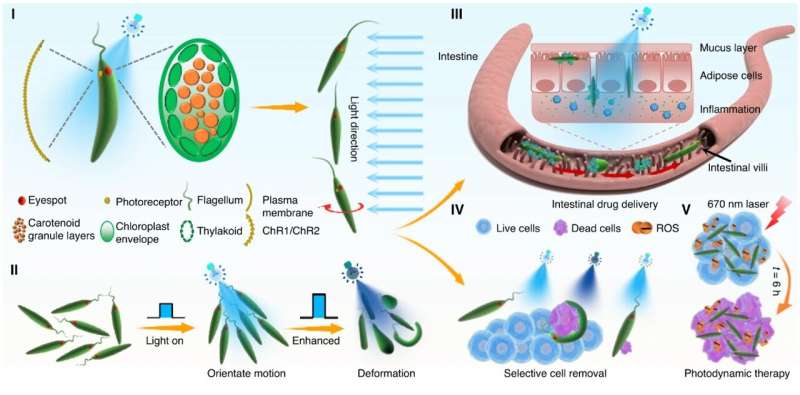This article has been reviewed according to Science X's editorial process and policies. Editors have highlighted the following attributes while ensuring the content's credibility:
fact-checked
peer-reviewed publication
proofread
Turning microalgae into light-controlled, soft bio-microrobots

Micro/nanorobots, due to their small size, high controllability and precise navigation capabilities have emerged as an important tool to execute biomedical tasks in microenvironments. However, it is still a big challenge to maneuver rigid microrobots in complicated and sinuous narrow spaces (such as blood vessels and intestines) due to their inability to deform.
Developing highly controllable, deformable and environmentally adaptable soft microrobots is thus crucial for multiple task execution in narrow microenvironments, but selecting highly biocompatible materials to construct these microrobots remains problematic.
In a new paper published in Light: Science & Applications, a team of scientists led by Professor Hongbao Xin from Guangdong Provincial Key Laboratory of Nanophotonic Manipulation, Institute of Nanophotonics, Jinan University, China, have developed a smart strategy to transform a microalga (Euglena gracilis, widely found in nature) into a soft bio-microrobot (Ebot) controlled with blue LED light.
This microalga has good biocompatibility and environmental adaptability, can move freely and can deform in natural living states, but without controllability.
The photoreceptor at the back of the eyespot is extremely sensitive to blue light. Therefore, the researchers used a blue LED light with a center wavelength of 450 nm to control the Euglena gracilis. With different light intensity and irradiation duration, they find that the flagellar beating patterns and epidermal transverse mode sliding can be controlled by activating the light-sensitive photoreceptor and calcium ion channels.
The Euglena gracilis then becomes a light-controlled soft bio-microrobot (Ebot) with the capability of precision navigation and controllable deformation (Figure 1, left). This light-controlled navigation and deformation allows the Ebot to easily pass through narrow and curved microchannels.
The feature of deformability and high adaptability to different environments allows the Ebot to perform different biomedical tasks in narrow and changeable microenvironments such as complex microfluidic channels and intestinal mucosa. They have successfully demonstrated the task execution capability of targeted drug delivery and selective removal of diseased cells in intestinal mucosa (Figure 1, right).
More importantly, since Euglena gracilis is rich in chlorophyll, the Ebot can perform photosynthesis to produce oxygen under light irradiation. While chlorophyll can be reduced to chlorophyll derivatives, by using a natural photosensitizer under light irradiation at a wavelength of 670 nm, the Ebot can be induced to perform precise photodynamic therapy on cancer cells in target areas.
This light-controlled soft microrobot provides a new bio-microrobotic tool that can execute multiple tasks, and will open a new avenue for future microrobotics in biomedical applications within complicated and sinuous narrow microenvironments.
Compared with conventional microrobots with chemical synthetic materials, there are many advantages of this microalga-based Ebot.
The researchers state, "First, without any chemical synthetic materials, the fabrication and control of this Ebot is very easy, and we can control the Ebot (either a single Ebot or multiple Ebots) simply with the irradiation of a blue light LED with different light intensity and duration.
"Second, this Ebot holds the feature of deformation, which enables it pass through complex and narrow biological microenvironments."
"Due to the photosynthesis of the microalga and the rich content of chlorophyll, the Ebot can be used as a natural photodynamic therapy tool," they added.
More information: Jianyun Xiong et al, Light-controlled soft bio-microrobot, Light: Science & Applications (2024). DOI: 10.1038/s41377-024-01405-5
Journal information: Light: Science & Applications
Provided by TranSpread





















